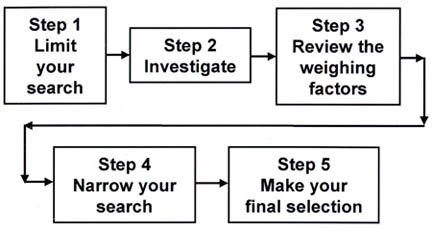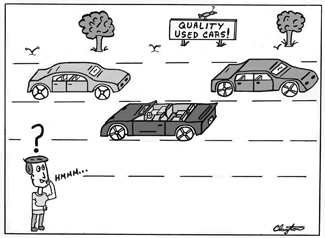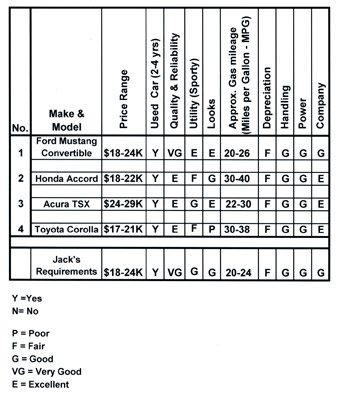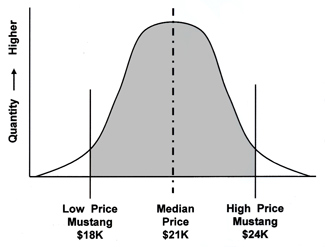|
A Comparison Study ExampleLet’s do a comparison study for purchasing a car.
Most people purchase a vehicle several times in their lifetime. Thus, it is a good example to illustrate the process.
First, lets review the steps of doing a study.
Comparison Studies
Step 1: Limit your search Most people have already decided on the type of car they want before searching for a vehicle. A mental comparison study has helped them determine it will be a family car, a luxury car, a truck etc. Assuming you have decided on the type of vehicle you want, your next task is to determine your selection criteria for the comparison study. Start with: price, quality/reliability and usefulness. Next, determine other features that interest you and are specific to automobiles. Define these by reading articles in used and new car book and/or magazines. Also review automobile websites for comparison studies. Look for the features that continue to show up again and again. Add these features to your selection criteria.
1. Price range — What is your budget for the car? Besides price, cost of a car includes tax, title and insurance costs. This usually adds 10-12% to the base price of the car. Several factors determine how much you can afford for a car. The important ones are:
* What is your income and other current expenses?
2. Quality/Reliability — How important is the quality and reliability of the car to you? 3. Usefulness (Utility) — Is this automobile for fun? Is it for a family? Is it for hauling things? How many people will frequently travel in the car? 4. Looks — How important are the looks of the car to you? 5. Gas mileage — How important is gas mileage to you? 6. Depreciation — How fast will the car depreciate? Is this important to you? 7. Handling — How easy is the car to handle? Does it take curves well? You will need to test drive it to find this out. 8. Power — Do you want a car with a lot of power to get in and out of traffic? 9. Company — Is there a particular automotive company that we would prefer to buy from because of past experiences?
Here are other considerations when shopping for a car. 10. New or used — How important is a new car to you? Typically, a new car loses 15-25% of its value when it is driven off the lot. The first two or three years usually have high depreciation rates as well. 11. Trade in or sell — Do you want to trade in your existing car or sell it on your own? Selling a car rather than trading it in will frequently be worth a thousand or more dollars. 12. Payments and down payment — How large are the payments? Do you want to pay the car off in two or three years, or will paying it off in four to six years be okay? Do you want to put the minimum down payment towards the car, or more? The more you apply towards a down payment, the less your monthly payments will be, or the less time to pay it off (or both).
Now, for this example let’s go through the steps to purchase a car. This process will be done for a single man, age thirty four who needs a car. I will name him Jack.
Jack has a good job and would like a sporty car that is attractive. However, he is on a budget. He plans on keeping the car 4-5 years before selling it. Jack would prefer a new car, but will consider purchasing a used one.
Step 2: Investigate To help learn about available cars Jack purchased two books at a bookstore. One of the books was on new cars, and other one was on used cars. He also investigated on the web as part of his comparison study. The books and sites on the Internet taught Jack about the benefits and drawbacks of different makes and models. They educated him about the features, options and prices of new and used cars. After reviewing the books and websites Jack made a list of cars he was interested in for the comparison study. Jack preferred a new car. After his investigation he discovered that by buying a two or three year old used car (that had a good 80% or more of its useful life remaining), he could save approximately 30-40% off what he would pay for a new vehicle. He decided that by purchasing a used car he would get the most car for his money. The comparison study was already paying off!
Here are the other factors Jack reviewed and decided on for the comparison study. 1. Price Range — Jack determined with his salary and other expenses he can afford $18-22K for a used car 2 – 4 years old with less than 30,000 miles on it. Jack discovered that a two or three year old car with low mileage was a sweet spot for getting an automobile. Note:A sweet spot is when the car has a good amount of life remaining, however has depreciated enough so that the cost is desirable. 2. Quality/Reliability — High reliability is important to Jack. He wanted a car that will last over 100, 000 miles with proper maintenance. 3. Usefulness (Utility) — Jack needed a car to drive to and from work, on vacations and around the city. He decided a sub-compact or a compact car would be economical to drive and maintain. He was interested in a sporty, but not a sports car (too expensive). Jack likes convertibles. 4. Looks — Jack is single and wanted an attractive car. 5. Gas mileage — Jack wanted a car that gets a minimum of 20 miles per gallon in the city and 24 miles on the highway. 6. Depreciation — Jack wanted a car that doesn’t depreciate radically. He felt that if he purchased a reliable car the depreciation should be acceptable. Since he will purchase a reliable used car (2-3 years old) a significant portion of the deprecation has already occurred. 7. Handling — Jack wanted a car that handles well in good and poor weather and hugs the road well when cornering. 8. Power — Jack wanted a car with good power, however doesn’t need excessive power. 9. Company — Jack doesn’t have a favorite company that he wants to buy from.
Other Considerations: 10. New or used —Jack decided to purchase a used car for the reasons noted earlier. 11. Trade in or sell — Jack decided to sell his current car himself (it is an Acura with 129K miles) instead of trading it in. He determined that he was able to make $1,200-$1,500 more than if he traded it in. 12. Payments and down payment — Jack decided he would try to put the money from the sale of the Acura as a down payment. He would then take out a four year loan and start making higher payments so he could pay off the loan in two or three years and save on interest.
Step 3: Review the weighing factors
Jack decided that price, quality/reliability, usefulness and looks were the most important factors in the comparison study in his choice of an automobile.
Step 4: Review Narrow Your Search
To narrow his search, Jack invested more time looking through the used car book he purchased along with websites that sell used cars. He read reviews on each of the models and looked at any comparison study that already existed. Jack narrowed his search to four models. They were: • The Ford Mustang Convertible — Mustangs have good reliability and quality. Jack liked their handling. The used Mustangs were reasonably priced and get satisfactory gas mileage. Jack liked the convertible and found the Mustang’s appearance attractive. He located several used cars in his city that were 2-3 years old and within his price range. • The Honda Accord — Jack was impressed with the reliability and quality of these cars. The appearance was appealing to him. The price and gas mileage were reasonable. • The Acura TSX — Jack liked the reputation of Acura. The used cars were reliable, attractive to him and roomy inside. However, the used cars were expensive. • The Toyota Corolla — Jack liked and reliability of the car, and the company reputation. However he didn’t feel it was an attractive car.
Choosing the Right Car!
Step 5: Make your final selection Jack visited several car dealers of the brands noted above. He test drove each of the models. Test driving information is factored into subjective information such as handling, and power. Jack decided to purchase his car from a car dealer instead of a private individual. He wanted a warranty and inspection report on the car which he could only get through a dealer. Again, the comparison study was paying off. Although Jack liked many features about the Acura TSX, it was more expensive than he felt could afford in comparison to the prices for the other cars. The Toyota Corolla was a good car, but Jack didn’t find it attractive. He liked both the Honda Accord and Mustang. He finally decided on the Mustang convertible. Besides the good reliability and price he liked its handling and appearance. He also chose it because it was a convertible. Below is a comparison study chart Jack created to contrast the cars he was interested in. The columns are filled in using two sources of information. First, the chart includes objective information such as gas mileage and price. Jack learned about these by reading articles and reports in books, magazines and on the web. And second, the table includes subjective information factored in by test driving the cars.
Jack’s Automobile Comparison Study Form
The price ranges Jack found most commonly are noted in the table. This can be charted on a figure commonly used in statistics known as a Normal Curve (Also known as a Normal Distribution Curve). A normal curve charts the average cost of each vehicle verses the quantity at that price. It is useful for Jack because it helps him focus his attention on cars within a fair price range. Jack found prices outside of these ranges, however they weren’t that common. Cars that were significantly lower prices usually had been in an accident, or needed significant repairs. More expensive cars usually had an inflated price. Below is a Normal Curve for the Mustang Convertible that shows Jack’s selected price range.
A Normal Curve of Mustang Convertible Costs
Once Jack decided on purchasing a used Mustang convertible, he negotiated with various dealers on the price. To negotiate a fair price, he used comparable age, mileage and options information from used car books, prices he found on the Internet and at the various dealers he visited. Using the comparison study steps shown, Jack was able to successfully fulfill his need for a good, reliable and attractive car.
Reviewing Comparison Studies
Comparison studies have a wide array of uses. For example, they can be used to help make decisions on homes, cars and computers. A comparison study can also be used to decide on which college to attend, what career to pursue and more. Before ending this chapter it is worth noting again how to determine the important factors when setting up any trade study. They are: 1. Start with the following factors.
• Price
2. Next, during your investigation look for:
• Features that continue to show up again and again.
Do you want to unlock the power of critical thinking and create an amazing future? If so, click the link and get your copy of Mastering Critical Thinking today! Return from Comparison Study Example to Problem Solving Techniques |





